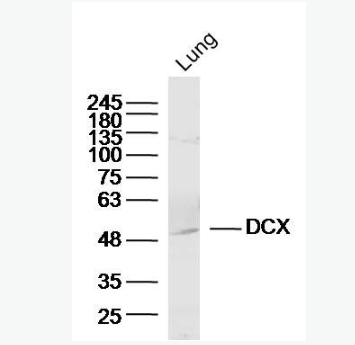| 中文名稱 | 雙皮質(zhì)素抗體 |
| 別 名 | Doublecortex; DBCN; Dbct; DC; Doublin; Lis X; Lissencephalin X; Lissencephaly X linked; Lissencephaly X linked doublecortin; LISX; Neuronal migration protein doublecortin; SCLH; XLIS. |
| 研究領域 | 細胞生物 神經(jīng)生物學 細胞粘附分子 |
| 抗體來源 | Rabbit |
| 克隆類型 | Polyclonal |
| 交叉反應 | Human, Mouse, Rat, |
| 產(chǎn)品應用 | WB=1:500-2000 ELISA=1:500-1000 IHC-P=1:100-500 IHC-F=1:100-500 ICC=1:100-500 IF=1:100-500 (石蠟切片需做抗原修復) not yet tested in other applications. optimal dilutions/concentrations should be determined by the end user. |
| 分 子 量 | 49kDa |
| 細胞定位 | 細胞漿 |
| 性 狀 | Liquid |
| 濃 度 | 1mg/ml |
| 免 疫 原 | KLH conjugated synthetic peptide derived from human DCX:311-400/441 |
| 亞 型 | IgG |
| 純化方法 | affinity purified by Protein A |
| 儲 存 液 | 0.01M TBS(pH7.4) with 1% BSA, 0.03% Proclin300 and 50% Glycerol. |
| 保存條件 | Shipped at 4℃. Store at -20 °C for one year. Avoid repeated freeze/thaw cycles. |
| PubMed | PubMed |
| 產(chǎn)品介紹 | Doublecortin (DCX) is a microtubule-associated protein expressed almost exclusively in immature neurons. Neuronal precursors begin to express DCX shortly after exiting the cell cycle, and continue to express DCX for 2-3 weeks as the cells mature into neurons. Downregulation of DCX begins after 2 weeks, and occurs at the same time that these cells begin to express, a marker for mature neurons. Due to the nearly exclusive expression of DCX in developing neurons, this protein has been used increasingly as a marker for neurogenesis. Indeed, the levels of DCX expression increase in response to exercise, which occurs in parallel with increased BrdU labelling, currently a "gold standard" in measuring neurogenesis. Function: Microtubule-associated protein required for initial steps of neuronal dispersion and cortex lamination during cerebral cortex development. May act by competing with the putative neuronal protein kinase DCAMKL1 in binding to a target protein. May in that way participate in a signaling pathway that is crucial for neuronal interaction before and during migration, possibly as part of a calcium ion-dependent signal transduction pathway. May be part with LIS-1 of a overlapping, but distinct, signaling pathways that promote neuronal migration. Subunit: Interacts with tubulin. Subcellular Location: Cytoplasm. Cell projection. Note=Localizes at neurite tips. Tissue Specificity: Highly expressed in neuronal cells of fetal brain (in the majority of cells of the cortical plate, intermediate zone and ventricular zone), but not expressed in other fetal tissues. In the adult, highly expressed in the brain frontal lobe, but very low expression in other regions of brain, and not detected in heart, placenta, lung, liver, skeletal muscles, kidney and pancreas. Post-translational modifications: Phosphorylation by MARK1, MARK2 and PKA regulates its ability to bind mirotubules. DISEASE: Defects in DCX are the cause of lissencephaly X-linked type 1 (LISX1) [MIM:300067]; also called X-LIS or LIS. LISX1 is a classic lissencephaly characterized by mental retardation and seizures that are more severe in male patients. Affected boys show an abnormally thick cortex with absent or severely reduced gyri. Clinical manifestations include feeding problems, abnormal muscular tone, seizures and severe to profound psychomotor retardation. Female patients display a less severe phenotype referred to as 'doublecortex'. Defects in DCX are the cause of subcortical band heterotopia X-linked (SBHX) [MIM:300067]; also known as double cortex or subcortical laminar heterotopia (SCLH). SBHX is a mild brain malformation of the lissencephaly spectrum. It is characterized by bilateral and symmetric plates or bands of gray matter found in the central white matter between the cortex and cerebral ventricles, cerebral convolutions usually appearing normal. Note=A chromosomal aberration involving DCX is found in lissencephaly. Translocation t(X;2)(q22.3;p25.1). Similarity: Contains 2 doublecortin domains. SWISS: O43602 Gene ID: 1641 Database links: Entrez Gene: 1641 Human Entrez Gene: 13193 Mouse Entrez Gene: 84394 Rat Omim: 300121 Human SwissProt: O43602 Human SwissProt: O88809 Mouse SwissProt: Q9ESI7 Rat Unigene: 34780 Human Unigene: 12871 Mouse Unigene: 121471 Rat Important Note: This product as supplied is intended for research use only, not for use in human, therapeutic or diagnostic applications. 神經(jīng)細胞標志物(Neuronal Marker) |
| 產(chǎn)品圖片 | 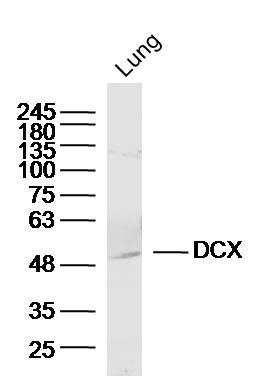 Sample:Lung (Mouse) Lysate at 40 ug Sample:Lung (Mouse) Lysate at 40 ugPrimary: Anti-DCX (bs-20798R) at 1/300 dilution Secondary: IRDye800CW Goat Anti-Rabbit IgG at 1/20000 dilution Predicted band size: 49 kD Observed band size: 49 kD 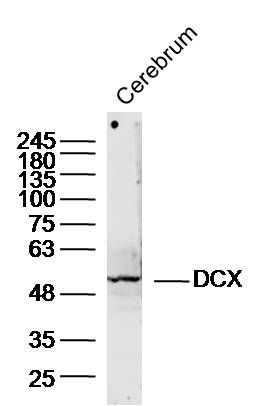 Sample:Cerebrum (Mouse) Lysate at 40 ug Sample:Cerebrum (Mouse) Lysate at 40 ugPrimary: Anti-DCX (bs-20798R) at 1/300 dilution Secondary: IRDye800CW Goat Anti-Rabbit IgG at 1/20000 dilution Predicted band size: 49 kD Observed band size: 49 kD 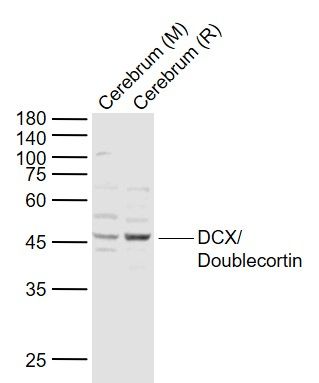 Sample: Sample:Lane 1: Cerebrum (Mouse) Lysate at 40 ug Lane 2: Cerebrum (Rat) Lysate at 40 ug Primary: Anti-DCX/Doublecortin (bs-20798R) at 1/1000 dilution Secondary: IRDye800CW Goat Anti-Rabbit IgG at 1/20000 dilution Predicted band size: 45 kD Observed band size: 45 kD 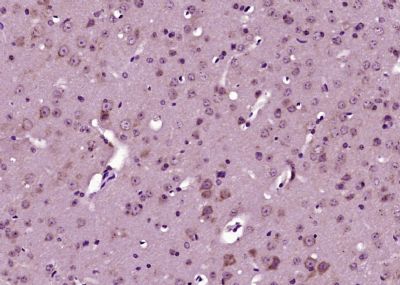 Paraformaldehyde-fixed, paraffin embedded (Mouse brain); Antigen retrieval by boiling in sodium citrate buffer (pH6.0) for 15min; Block endogenous peroxidase by 3% hydrogen peroxide for 20 minutes; Blocking buffer (normal goat serum) at 37°C for 30min; Antibody incubation with (DCX/Doublecortin) Polyclonal Antibody, Unconjugated (bs-20798R) at 1:400 overnight at 4°C, followed by operating according to SP Kit(Rabbit) (sp-0023) instructionsand DAB staining. Paraformaldehyde-fixed, paraffin embedded (Mouse brain); Antigen retrieval by boiling in sodium citrate buffer (pH6.0) for 15min; Block endogenous peroxidase by 3% hydrogen peroxide for 20 minutes; Blocking buffer (normal goat serum) at 37°C for 30min; Antibody incubation with (DCX/Doublecortin) Polyclonal Antibody, Unconjugated (bs-20798R) at 1:400 overnight at 4°C, followed by operating according to SP Kit(Rabbit) (sp-0023) instructionsand DAB staining.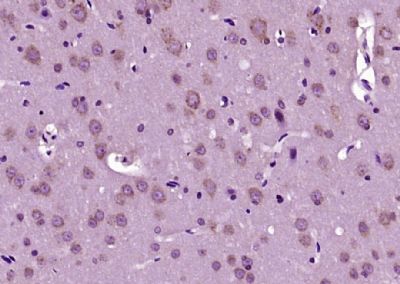 Paraformaldehyde-fixed, paraffin embedded (Rat brain); Antigen retrieval by boiling in sodium citrate buffer (pH6.0) for 15min; Block endogenous peroxidase by 3% hydrogen peroxide for 20 minutes; Blocking buffer (normal goat serum) at 37°C for 30min; Antibody incubation with (DCX/Doublecortin) Polyclonal Antibody, Unconjugated (bs-20798R) at 1:400 overnight at 4°C, followed by operating according to SP Kit(Rabbit) (sp-0023) instructionsand DAB staining. Paraformaldehyde-fixed, paraffin embedded (Rat brain); Antigen retrieval by boiling in sodium citrate buffer (pH6.0) for 15min; Block endogenous peroxidase by 3% hydrogen peroxide for 20 minutes; Blocking buffer (normal goat serum) at 37°C for 30min; Antibody incubation with (DCX/Doublecortin) Polyclonal Antibody, Unconjugated (bs-20798R) at 1:400 overnight at 4°C, followed by operating according to SP Kit(Rabbit) (sp-0023) instructionsand DAB staining. |
我要詢價
*聯(lián)系方式:
(可以是QQ、MSN、電子郵箱、電話等,您的聯(lián)系方式不會被公開)
*內(nèi)容:


